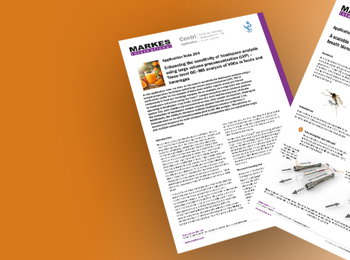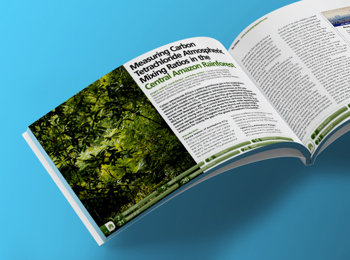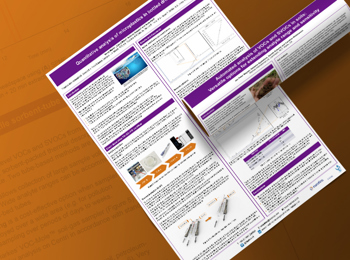
The science beneath your feet - untargeted approaches to volatile organic compound (VOC) emissions from soil
31 October 2024
In the agricultural sector, the quality of the soil is vital in determining the productivity, sustainability, and overall success of farming practices – from crop growth quality to carbon sequestration. Unexpected weather events such as flooding, temperature changes, and high winds can have a major impact on soil conditions, leading to problems with farming and biodiversity. So how do you monitor the state of your soil to ensure it is fit for purpose?
Why VOC extraction is important for soil analysis
Soil microbes emit VOCs when subjected to different environmental conditions. These emissions are indicative of soil health and play a key role in monitoring, and improving, soil quality.1 In traditional analyses, soil is taken from the sampling site and analysed with solvent-based methods to extract VOCs. Confident VOC profiling of soil with solvent-extraction methods is hampered by the inherent dilution effect of liquid-liquid extraction and extraction bias introduced by the solvents, therefore impacting sensitivity.2
Due to the complexity of its matrix, VOC profiling can be challenging, as biological and chemical factors can alter conditions over time. Therefore, a cost-effective, robust, and sensitive technique that can be used either in situ or ex situ, without the need for solvents, would be very effective in monitoring soil health. In recent years, a push for more sustainable alternative techniques has seen an increase in the use of sorptive extraction.3,4,5 This technique removes the need for solvents, aligning with goals 1 (prevent waste) and 5 (use safer solvents and reaction conditions) of the 12 green chemistry principles.6
Using VOC profiles to understand soil quality
Dr Rob Brown, a biogeochemist in the Ecosystems and Environment group at the University of Bangor, UK, has shed light on this topic in a recent publication.7 In this study, the group looked at three soil treatments that were simulated to mimic 'good', 'medium' and 'poor' soil quality in order to determine if VOC profiles changed when soil quality is altered. The soil treatments were simulated as follows: 'Good' treatment was 5% soil improver (1:2 w/w soil improver: soil), medium had no amendment, and poor had a 5% grass residue loading saturated with river water to create anaerobic conditions. They found that poor quality soil had the most diverse VOC profile, with a higher concentration of aromatic, carboxylic acid and sulfur compounds that can have a negative impact on plants in high concentrations, especially on the plants' root systems.8
In comparison, a higher number of aldehydes were detected in the good and medium quality soils, so they could be used as potential markers of quality for each of the treatments. Moreover, certain compounds unique to the 'poor' quality soil correlated with potential issues with the soil health, such as 2-methyl-1H-indole, which is highly toxic to microorganisms; 2-methylpyridine, which is a bacterial and fungal secondary metabolite; and aniline, which is used in the synthesis of herbicides.7 These findings highlight the potential of VOC profiling as a marker for soil quality, with specific compounds indicating the health of the soil.
Profiling VOC emissions from soil: comparison of solvent-free extraction techniques
The extraction techniques used by the team at the University of Bangor to profile the soil were sorptive extraction, specifically solid phase microextraction (SPME), SPME with multi-step enrichment (MSE®), and high-capacity sorptive extraction (HiSorb™). With SPME, analytes are preconcentrated onto a sorptive phase. MSE allows multiple SPME extractions from the same sample to be taken, stacked on a sorbent-packed focusing trap, and analysed in a single GC injection. The sampling mechanism of HiSorb has the same premise as SPME but with a higher phase capacity and surface area, allowing an increase in the number and abundance of analytes extracted.
Dr Brown found that recovery of key analytes was substantially improved using SPME-MSE, extracting an increased 455% total peak area yield compared with a single SPME extraction.7 He also found that both SPME-MSE and HiSorb (using a polyacrylate (PA) phase and PDMS-only phase respectively) detected either an equal or greater number of compounds with varying functional groups across all treatments when compared with single extraction SPME, and were also able to extract compounds unique to the extraction media. These included furfural, a compound used for synthesis of inks, plastics, fungicides8 and 2-methylbutanal, a common plant metabolite.9
Overall, HiSorb and SPME-MSE improved sensitivity and analyte range compared to a single SPME extraction across all treatments, delivering a more comprehensive soil profile and highlighting potential markers that could be able to determine soil health. HiSorb provides potential for further work via in situ sampling, essential for accounting for the dynamic influence of environmental factors over time, offering a more representative and holistic understanding of soil conditions.
References
- https://link.springer.com/article/10.1007/s11104-006-9190-4
- Sample preparation for the analysis of volatile organic compounds in air and water matrices - ScienceDirect
- https://www.sciencedirect.com/science/article/pii/S277258202200047X
- https://pubs.acs.org/doi/abs/10.1021/acs.analchem.0c02493
- https://www.sciencedirect.com/science/article/abs/pii/S2214158821000283
- https://www.epa.gov/greenchemistry/basics-green-chemistry#:~:text=12.,and%20releases%20to%20the%20environment
- Dependence of thermal desorption method for profiling volatile organic compound (VOC) emissions from soil - ScienceDirect
- https://www.ncbi.nlm.nih.gov/pmc/articles/PMC5816133/#:~:text=Sulfur%20is%20a%20common%20element,reduced%20growth%20(Tomlinson%201983)
- https://www.sciencedirect.com/topics/chemistry/furfural#:~:text=Furfural%20is%20used%20for%20making,and%20levulinic%20acid%20(LA)





![Markes TD Brochure Hero3 Corepurple[2]](/media/zmscvqds/markes-td-brochure-hero3-corepurple-2.jpg?cc=0.55128205128205132,0,0,0&width=350&height=260&v=1d660d04edbcca0)




